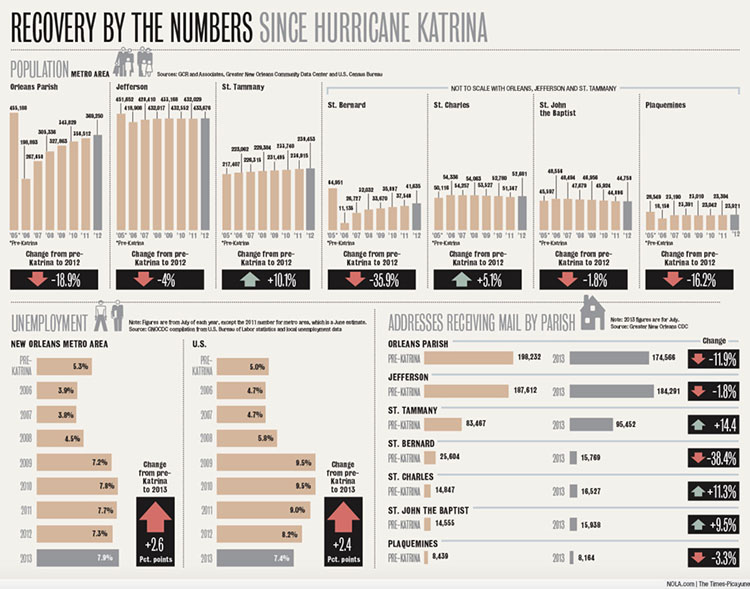Case Study: New Orleans and Katrina
Katrina in New Orleans - Economic Recovery Case Study
Hurricane Katrina in 2005 was a precursor to many similar events to come, and has become a yardstick by which to measure other storms impacting the U.S. since then. Katrina was and still is the deadliest and costliest storm to make landfall in the United States in 100 years. Hurricanes Harvey and Maria follow closely behind in costs and loss of life. Katrina impacted coastal communities in five Gulf Coast states - Florida, Alabama, Mississippi, Louisiana, and Texas. The greatest impacts were felt in Louisiana and Mississippi, while the greatest media attention focused on New Orleans. Katrina’s death toll was approximately 1,500 in Louisiana alone. The economic impacts were complex and enormous. If measured by insurance claims alone, the disaster generated more than 1.7 million claims across six states, to a total of more than $40 billion. Estimates of the overall economic impact of the storm in the Gulf states put the damage at approximately $200 billion!
The New Orleans economy is based on three main sectors: tourism, port operations, and educational services (Monthly Labor Review, 2007). All these sectors were essentially shut down after the storm for several months, and up to years in some cases. Many operations did not fully recover until a full year after the storm. The University of New Orleans and all other schools were closed except for online learning for the fall semester or longer. The Port of New Orleans is essential to the nation, as the Port of South Louisiana (of which New Orleans port is a component) handles the most bulk tonnage of any port in the world. About 5,000 ships from nearly 60 countries dock at the Port of New Orleans each year (Monthly Labor Review, 2007). The tourism service industry, for which New Orleans is best known, is the major employer in the city and, of course, that was also shut down for many months after Katrina. So, as well as being displaced, many New Orleans residents lost their source of income until the city could recover sufficiently, which took years.
These examples do not tell the whole story of a complex natural disaster such as Hurricane Katrina. Some have described it as a man-made disaster because of the failure of the flood control system surrounding the city of New Orleans, much of which sits at below sea level elevations. Meanwhile, a short distance away, unprotected coastal communities on the Louisiana and Mississippi coasts were also devastated. Some areas were never rebuilt, but most have been rebuilt, and this rebuilding has been a complex process driven by economic resources. Insurance payments; federally funded programs such as the Road Home Program, as well as people, organizations, and companies willing to invest in rebuilding the city all contributed to the patchwork of means by which the region recovered, house by house, neighborhood by neighborhood.
View the following image: a summary of the changes in population in the Greater New Orleans area in the eight years following Hurricane Katrina from The Times-Picayune.

